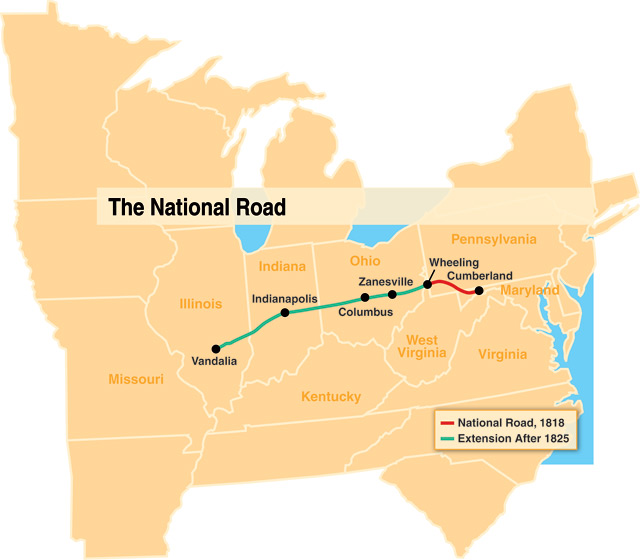George Washington’s Battle Experience Led to First National Road for Freight
 An artist's rendering shows traffic on the National Road between Cumberland, Md., and Wheeling, W.Va., in front of a traveler's tavern. It was one of the first federal infrastructure projects. (National Park Service)
An artist's rendering shows traffic on the National Road between Cumberland, Md., and Wheeling, W.Va., in front of a traveler's tavern. It was one of the first federal infrastructure projects. (National Park Service)This story appears in the Jan. 4 print edition of Transport Topics.
FORT NECESSITY, Pa. — Dwight Eisenhower is often cited for the major role he played in making surface transportation an important federal responsibility, but the idea didn’t start with Ike. It goes back to the first popular general-turned-president — George Washington.
A visit to this battlefield near Farmington run by the National Park Service will teach you a lot, not just about the French and Indian War but also how the war experience convinced Washington, then a lieutenant colonel in the British army, of the need for a commercial road stretching to the west.
The National Road that Washington envisioned, and hoped to profit from personally, was not built by the time he died in 1799, but it did open in 1818, linking Cumberland, Maryland, on the Potomac River with what would become Wheeling, West Virginia, on the Ohio River. Within 20 years, the road was extended west to its terminus in Vandalia, Illinois.
This linked the Eastern Seaboard first with the Ohio valley and then with the Mississippi valley.
It was one of the first grand federal infrastructure projects, and it led to fights over whether it should be done at all, where the road should run, who should pay for it and how it should be financed.
Washington became involved with the road, said Brian Reedy, chief of interpretation and visitor services at the Fort Necessity Battlefield and Friendship Hill National Historic Site, because the British crown “wanted to expel the French from Fort Duquesne, which later became Pittsburgh.”
Rivers were the best way to move goods in 18th-century North America, Reedy said, but roads were necessary to supplement the transportation network. The British wanted a way to move from the Potomac in Cumberland to Brownsville, Pennsylvania, on the Monongahela River.
 National Park Service
National Park ServiceWashington built a corduroy road — sand covering a foundation of felled trees — that was later improved by Maj. Gen. Edward Braddock, who died in combat nearby in 1755. Then, Washington buried Braddock underneath the road.
All of the fighting led Washington to appreciate the area’s commercial value, Reedy said.
“In the 1770s, he started purchasing land, and eventually he owned about 60,000 acres, including 234 acres at the Great Meadows,” around the fort. Washington thought roads would help cement pioneers in the Ohio Valley to the established East, and Great Meadows would be a “choice piece of land” for a tavern, where travelers could eat, drink, sleep and rest the draft animals that pulled wagons.
The 19th-century Fort Washington tavern that still stands was built on land once owned by Washington. In 1784, then-Gen. Washington shared his vision with Albert Gallatin, a young immigrant to Pennsylvania from Switzerland who later became secretary of the Treasury for Presidents Jefferson and Madison.
Gallatin strongly supported a federal road and came up with a clever way to pay for it, brokering legislation in 1806 that Jefferson signed.
“He sold federal land in Ohio and used that money and customs tariffs,” Reedy said. Pumping the money into transportation made sense because Ohio entered the union in 1803, and it was important to link those new citizens with the rest of the nation.
Once the National Road was completed by the federal government, maintenance was transferred to the states. Tolls were charged based on vehicle size and the number of animals being transported.
“Families heading west in ox carts did use the road,” Reedy said, “but they were a small percentage. The main users were freight haulers, farmers, business travelers and stagecoaches.”
Conestoga wagons pulled by teams of four to eight horses were the Class 8s of the day. They moved loads of 4,000 to 10,000 pounds that included feathers, whale oil, iron stoves, federal mail and bank notes. There was also livestock such as pigs, sheep, cattle and turkeys.
The Conestoga wagons with their Clydesdale-like horses “were well-designed for the hilly terrain” of western Pennsylvania, Reedy said.
The road thrived from its opening in 1818 until the early 1850s, when railroads became dominant. The road didn’t close, but it “withered,” he said.
The rise of Henry Ford’s automobiles restored the road. Car enthusiasts had been advocating for more and better roads, and by the 1920s, Congress had to listen.
The old National Road was brought up to highway standards and became what is now U.S. 40, and it passes right in front of Fort Necessity. Much of modern America doubtlessly would confuse or horrify a reincarnated George Washington, but he surely would enjoy driving in comfort from Cumberland to Pittsburgh on a federal road.

